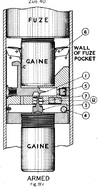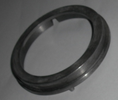This is just a thought that occured to me an I was wondering if any one had any thoughts as to if it was feasable. Not that I am going to encounter this situation and I would be leaving to to others for self preservation reasons.
The Zus 40 was intended to prevent the removal of the fuze above it and would fire when the gaine of the top fuze was withdrawn from the top cavity. The Zus 40 has blades to prevent it being removed with the upper fuze.

The whole fuze assembly is held into the bomb by a lock ring (just a externally threaded nut) and a locating ring (has a notch for the locating pin on the fuze and a pin to orientate the ring to bomb body).


So the question is this: Would it be possible to remove the upper fuze leaving the Zus 40 and the gaine from the upper fuze in the bomb by undoing the lockring, removing the locating ring and turning the upper fuze to unscrew the gaine? This obviously relies on using the blades in the Zus 40 to provide sufficient grip on the upper fuze gaine to allow it to be unscrewed. And would obviously be risky proposition with a Type 17 upper fuze as turning it round multiple times would mess with the clockwork mechanism even with a magnet stopping it. It would be suicidal with a Type 50 in the mix.
As well a pondering stuff I am looking for some information, if anyone could provide or point me in the right direction for the dimensions (have very rough ones but am looking for something a bit more accurate) of fuze, fuze pocket, lockring and locating ring for German (Rheinmetall Electic Fuzes) ww2 SC-50 and SC-250 bombs?
And does any one know if there is statistics (internet, books, archives) for number of German ww2 bombs dropped, numbers of UXBs, fuze type for UXBs, UXB result (unprovoked detonation, detonated by external factor, defuzed) out there anywhere?
Many thanks
Peter
The Zus 40 was intended to prevent the removal of the fuze above it and would fire when the gaine of the top fuze was withdrawn from the top cavity. The Zus 40 has blades to prevent it being removed with the upper fuze.

The whole fuze assembly is held into the bomb by a lock ring (just a externally threaded nut) and a locating ring (has a notch for the locating pin on the fuze and a pin to orientate the ring to bomb body).


So the question is this: Would it be possible to remove the upper fuze leaving the Zus 40 and the gaine from the upper fuze in the bomb by undoing the lockring, removing the locating ring and turning the upper fuze to unscrew the gaine? This obviously relies on using the blades in the Zus 40 to provide sufficient grip on the upper fuze gaine to allow it to be unscrewed. And would obviously be risky proposition with a Type 17 upper fuze as turning it round multiple times would mess with the clockwork mechanism even with a magnet stopping it. It would be suicidal with a Type 50 in the mix.
As well a pondering stuff I am looking for some information, if anyone could provide or point me in the right direction for the dimensions (have very rough ones but am looking for something a bit more accurate) of fuze, fuze pocket, lockring and locating ring for German (Rheinmetall Electic Fuzes) ww2 SC-50 and SC-250 bombs?
And does any one know if there is statistics (internet, books, archives) for number of German ww2 bombs dropped, numbers of UXBs, fuze type for UXBs, UXB result (unprovoked detonation, detonated by external factor, defuzed) out there anywhere?
Many thanks
Peter


